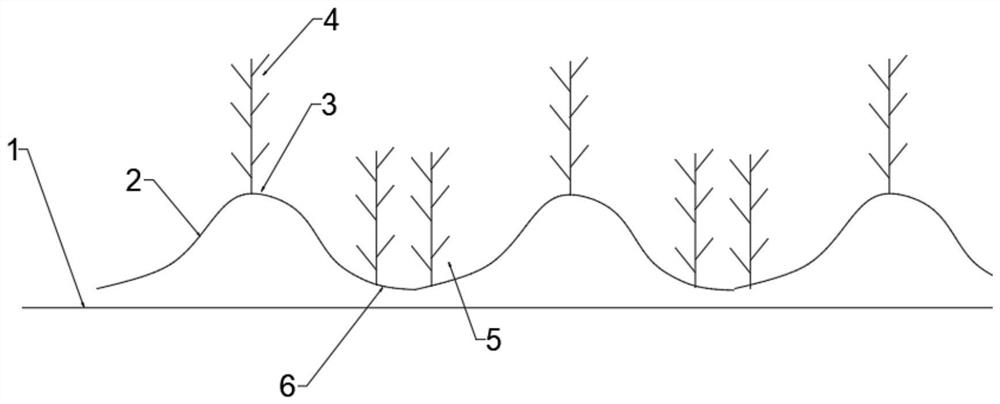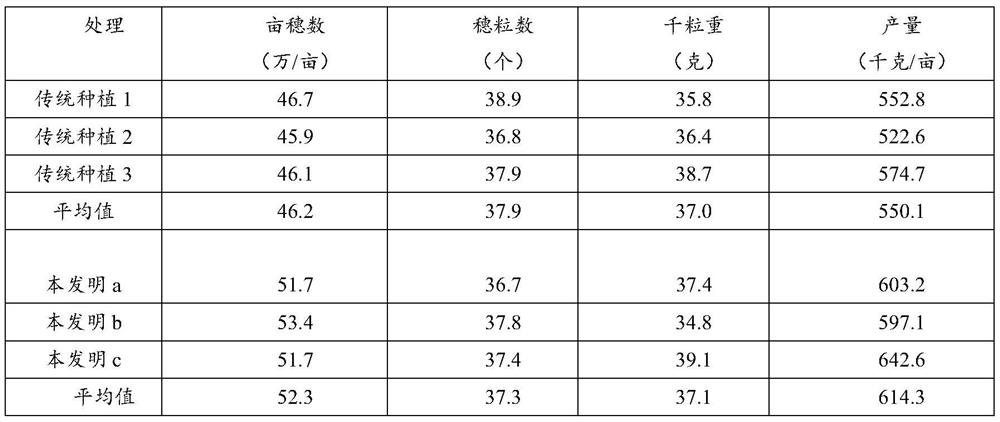Cultivation method for increasing interception amount of optical energy of wheat
A cultivation method and wheat technology, which is applied in the field of cultivation to increase the light energy interception of wheat, can solve the problems of increasing labor intensity and wheat production cost, uneven taste of flour, and little production significance, etc., so as to increase the surface area of farmland, improve Group, the effect of increasing the light energy interception rate
- Summary
- Abstract
- Description
- Claims
- Application Information
AI Technical Summary
Problems solved by technology
Method used
Image
Examples
Embodiment 1
[0027] The autumn of 2012 carried out the traditional flat furrow planting method (the sowing width is 150cm, planting 10 rows of wheat, and the sowing rate is 10 kg / mu) and the comparative test of the present invention in Jinhai Seed Industry Co., Ltd., Laizhou City, Shandong Province.
[0028] A kind of cultivation method of improving wheat light energy interception of the present invention, arable land is set as the furrow structure of wide and narrow row.
[0029] Ridging 2 of the wide row of cultivated land, ditch 5 of narrow row.
[0030] Ridge 2 is 8cm wide, and ditch 5 is 5cm wide.
[0031] The height difference between the ridge top 3 and the ditch bottom 6 is 8cm.
[0032] One row of wheat is planted at the top of the ridge 3, and two rows of wheat are planted at the bottom of the ditch 6.
[0033] Ridge top 3 planting wheat 4 seeding depth is 6cm, ditch bottom 6 planting wheat 4 planting depth is 4cm, ridge top 3 and ditch bottom 6 planting wheat 4 seed height dif...
Embodiment 2
[0041] In the autumn of 2018, the repeat verification test of the present invention was carried out in the experimental field of the Crop Research Institute of Shandong Academy of Agricultural Sciences:
[0042] A kind of cultivation method of improving wheat light energy interception of the present invention, arable land is set as the furrow structure of wide and narrow row.
[0043] Ridging 2 of the wide row of cultivated land, ditch 5 of narrow row.
[0044] Ridge 2 is 10cm wide, and ditch 5 is 7cm wide.
[0045] The height difference between the ridge top 3 and the ditch bottom 6 is 10cm.
[0046] One row of wheat is planted at the top of the ridge 3, and two rows of wheat are planted at the bottom of the ditch 6.
[0047] Ridge top 3 planting wheat 4 sowing depths is 5cm, ditch bottom 6 planting wheat 4 sowing depths is 5cm, ridge top 3 and ditch bottom 6 planting wheat 4 seed height differences are 10cm.
[0048]The cultivation method requires small water seepage to p...
Embodiment 3
[0060] In the autumn of 2018, an evaluation and verification test of farmland water and nitrogen supply capacity was carried out in Yueyang Professional Cooperative, Mazhuang Town, Tai'an City: the cultivation method was the same as in Example 1.
[0061] The tested variety: Taimai 18 (big spike variety), sowed on October 7, 2018, with a sowing rate of 12 kg / mu. On October 20, the basic seedlings surveyed were 208,700 plants / mu. Overwintering, harvested on June 7, 2019. During the experiment, the water content (Table 5) and nitrogen (Table 6) of the soil before and after irrigation at the jointing stage of the wheat in the experimental field were investigated. The invention changes the traditional flat furrows into wide and narrow ridges, and the corresponding irrigation method also needs to be changed from flood irrigation with small water seepage to promote the combination of water and soil. After measuring the soil water content at the jointing stage, it can be seen that be...
PUM
 Login to View More
Login to View More Abstract
Description
Claims
Application Information
 Login to View More
Login to View More - R&D Engineer
- R&D Manager
- IP Professional
- Industry Leading Data Capabilities
- Powerful AI technology
- Patent DNA Extraction
Browse by: Latest US Patents, China's latest patents, Technical Efficacy Thesaurus, Application Domain, Technology Topic, Popular Technical Reports.
© 2024 PatSnap. All rights reserved.Legal|Privacy policy|Modern Slavery Act Transparency Statement|Sitemap|About US| Contact US: help@patsnap.com










